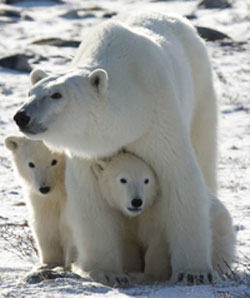 Even though a polar bears fur looks white it is actually colorless and is made with hollow tubes that scatter light and give a white appearance. The hollow tubes help the bear to stay warm by channeling the sun's energy directly to the bear's skin.
Even though a polar bears fur looks white it is actually colorless and is made with hollow tubes that scatter light and give a white appearance. The hollow tubes help the bear to stay warm by channeling the sun's energy directly to the bear's skin.
Only pregnant females polar bears hibernate.
Polar bear cubs learn to freeze and remain still while their mother hunts. If they move, the mother disciples them, with a whack to the head.
Polar bear fur is oily and water repellent. The hairs don't mat when wet, allowing the polar bears to easily shake free of water and any ice that may form after swimming.
Polar bears live along shores and on sea ice in the icy cold Arctic.
The polar bear is classified as a marine mammal. Its feet are partially webbed for swimming, and its fur is water-repellent.
The polar bear rivals the Kodiak bear as the largest four-footed carnivore on Earth and can live up to 25 years.
Most bears have few natural enemies except for humans.
Male polar bears are 8 to 11 feet long and weigh 500 to 1,100 pounds but can reach as much as 1,500 pounds.
Adult females often weigh between 500 and 600 pounds (227 and 272 kilograms).
Polar bears are strictly carnivores and feed or scavenge only meat.
Female polar bears measure 6 to 8 feet long and weigh from 350 to 600 pounds, occasionally reaching 700 pounds.
Polar bears can be found in the United States, Canada, Russia, Greenland and on the Arctic islands of Norway
Polar bears can swim an average of 6 miles per hour.
Polar bears can swim up to 100 miles (161 kilometers at a time).
The polar bear's entire body is furred, even the bottom of its paws.
Polar bears fur is oily and water repellant. Allowing them to shake dry after swimming.
The scientific name for the polar bear is Ursus maritimus, which means 'Sea Bear' in Greek.
Female polar bears do not start having cubs until they are about 4 or 5 years old.
Polar bear babies weigh a little more than a pound when they are born
Scientists estimate there are approximately 20,000 to 25,000 polar bears in the world as of 2008.
Paw pads with rough surfaces help prevent polar bears from slipping up on the ice.
Polar bears swim using their large front paws to propel themselves through the water and their back legs to steer.
Some female polar bears deviate from the one room den. They build dens with multiple rooms and even a ventilation system in the roof.
The average age of a polar bear in the wild is 17 years
When a polar bear cub is born it can not see or hear for approximately a month.
Polar bears have been known to swim more than 60 miles without a rest.
Polar bears have been spotted on sea ice hundreds of miles from shore.
Polar bears primarily eat seals.
Female polar bears would rather build their dens in "old snow" from previous years rather than the freshly fallen snow.
Polar bears depend mostly on their sense of smell to determine the location of prey.
Polar Bears do not hibernate. Female polar bears will den with their young. All polar bears may den for a short time to avoid bad weather.
Polar bears tend to overheat more than to be cold.
